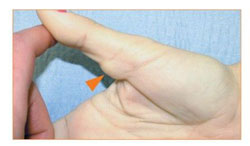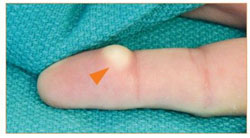 What is it?
What is it?
Tumors are defined as any abnormal lump, bump or “mass.” Calling something a tumor does not mean that it is cancerous. Actually, most tumors on the hand and wrist are benign. Regardless of cause, it’s still considered a tumor. They can present themselves as a mole, wart or bump underneath the skin. There are numerous types of hand tumors because there are so many types of tissues in the hand, but only a few are common.
Ganglion cysts are the most common kind of tumor and are usually located on the wrist or base of the fingers (see a more detailed description of Ganglion cysts on its own page). These cysts occur when the fluid that lubricates the joint thickens and creates a firm lump.
 The next most common type of tumor is the giant cell tumor of tendon sheath. These tumors are not filed with liquid like a Ganglion cyst, but are firm. They occur near a tendon sheath, which is the outer layer of lining which supports the tendon. These tumors are non-cancerous and grow slowly.
The next most common type of tumor is the giant cell tumor of tendon sheath. These tumors are not filed with liquid like a Ganglion cyst, but are firm. They occur near a tendon sheath, which is the outer layer of lining which supports the tendon. These tumors are non-cancerous and grow slowly.
A third common tumor is the epidermal inclusion cyst, which is benign and forms under the skin in an area where there may have been a cut. The cyst is made up of excess keratin, which is a waxy substance that protects skin. The cycst is sac-like and filled with a soft, cheese-like substance.
There are several other types of less common tumors that include lipomas (fatty tumors), neuromas (nerve tumors), nerve sheath tumors, fibroams, and glomus tumors. The vasty majority of all hand and wrist tumors are benign. Bone spurs, which may feel like hard tumors, can be caused by arthritis or injury. Patients also may confuse a foreign body, like a splinter, for a tumor.
 What causes it?
What causes it?
There are as many causes for hand tumors as there are types of tumors. The cause depends entirely on the type of tumor involved.
Fortunately, hand cancer is very rare. However, the most common types of cancer that begin in the hand are skin cancers. However, cancers that originate in other parts of the body can spread to the hand. A biopsy is required to determine the presence of cancerous cells.
What are the symptoms?
Most patients are alerted to the presence of a tumor by observing an unusual bump or lump that was not there before. There may be pain associated with it, but that isn’t true in all cases.
How do we diagnose it?
We must conduct a physical exam and carefully study your medical history in order to determine the type of tumor present. Several tests, such as x-rays, CT scans, an MRI or bone scan, might be used to assess the nature of the tumor and make an accurate diagnosis.
 How is it treated?
How is it treated?
The treatment with the lowest recurrence rate is a surgical excision of the tumor. When the tumor is removed, a pathologist will also analyze it to determine the type. Sometimes, we may want to determine the tumor type before removing it, so as to choose the best treatment option. In that case, a needle or incisional biopsy would be done. This type of surgery is usually done on as an outpatient procedure using local or regional anesthesia. Most types of tumors can be effectively treated with surgery.
Sometimes, if the tumor is benign, patients do not seek treatment and choose to live with it instead. If the appearance or feeling of the tumor changes, however, it’s recommended that you have it re-evaluated.


